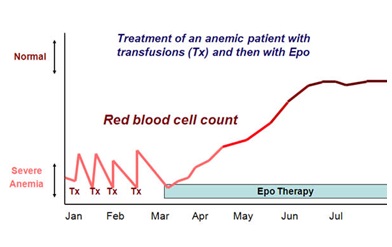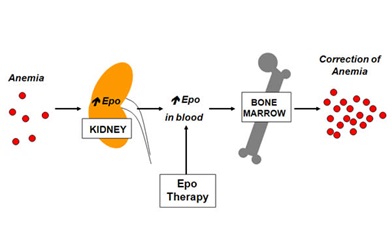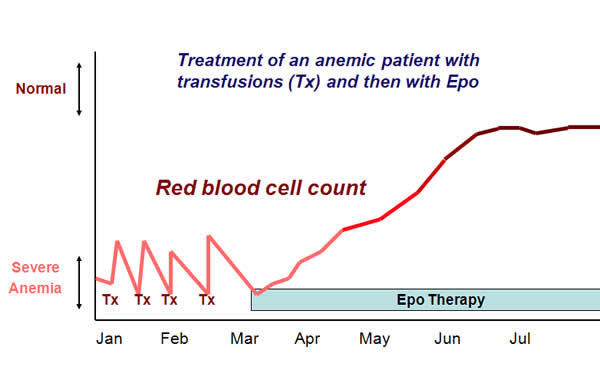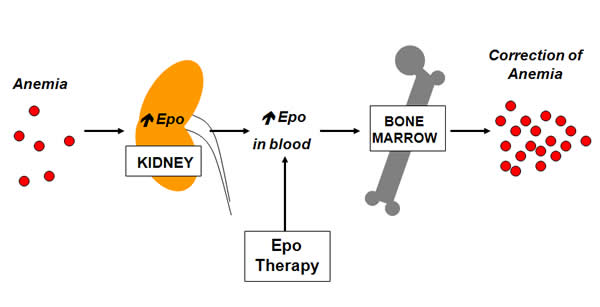The Story of Erythropoietin
This article was published in December 2008 as part of the special ASH anniversary brochure, 50 Years in Hematology: Research That Revolutionized Patient Care.
Millions of patients worldwide have benefited from research on erythropoietin spanning many decades. In the last 15 years, epoetin alfa (Epo) has become one of the most widely used drugs created through recombinant DNA technology, in which a nearly identical form of a substance that naturally occurs in the body - in this case, erythropoietin - is created by replicating human DNA in a laboratory. Epo is used to treat anemia, a shortage of red blood cells. Since red blood cells carry oxygen to the tissues and organs, anemia causes symptoms such as weakness, fatigue, and shortness of breath. Epo treats this condition by imitating the action of the hormone erythropoietin, stimulating the body to produce more red blood cells. Patients who may benefit from Epo therapy include those with chronic kidney disease, those who are anemic from AIDS or from a wide variety of hematologic disorders (including multiple myeloma and myelodysplastic syndromes), and some cancer patients who are anemic from receiving chemotherapy. In selected patients, Epo may be used to reduce the need for blood transfusions in surgery.
 label-modal-with-text-click-to-enlarge
label-modal-with-text-click-to-enlarge
A century ago, two French investigators reported that small amounts of plasma from anemic rabbits injected into normal animals caused an increase in red blood cell production (erythropoiesis) within a few hours. They referred to this activity as hemopoietine. Over time, as investigators became more convinced that this red-blood-cell stimulating activity was caused by a single protein in the blood plasma, they gave it a variety of names - erythropoietic-stimulating activity, erythropoietic-stimulating factor, and, ultimately, "erythropoietin."
It wasn't until the 1950s and '60s that several American investigators again took up the concept that a hormone regulated red cell production. Refining the work of the French scientists, the American investigators conclusively showed that a hormone stimulated red cell production, that the kidneys were the primary source of erythropoietin, and that low oxygen was the main driver of erythropoietin production. Soon, researchers found that patients with anemia responded by increasing their levels of erythropoietin to stimulate increased red blood cell production. Patients who required an increase in red blood cells in order to make up for low oxygen levels in the blood (such as patients with lung disease or patients living at high altitudes) also had elevated erythropoietin levels.
 label-modal-with-text-click-to-enlarge
label-modal-with-text-click-to-enlarge
At the same time, other technologies were being developed that set the stage for a remarkable breakthrough involving a combination of medical and molecular engineering. In the early 1960s came the development of hemodialysis, a method of removing waste products from the blood when the kidneys are unable to perform this function, to sustain the lives of patients with end-stage kidney disease. As a result of this treatment advance, these patients were able to survive the underlying disease, but their damaged kidneys could no longer make erythropoietin, leaving them severely anemic and in desperate need of Epo therapy.
In 1983, scientists discovered a method for mass producing a synthetic version of the hormone. Experiments were conducted to test the safety and effectiveness of the new drug, Epo, for treating anemia in patients with kidney failure. The results of these early clinical trials were dramatic. Patients who had been dependent on frequent blood transfusions were able to increase their red blood cell levels to near-normal within just a few weeks of starting therapy. Patients' appetites returned, and they resumed their active lives. It was the convergence of two technologies - long-term dialysis and molecular biology - that set the stage for anemia management in this group of patients. Since then, millions of patients worldwide have benefited from Epo therapy.

